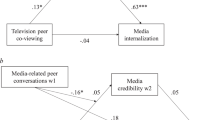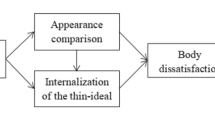The purpose of this research was to examine gender and body mass, as factors linked to perceived experiences within the peer appearance culture. The sample included 215 girls and 200 boys who were either in 7th grade or 10th grade. Students provided self-reports on experiences in three domains: appearance culture among friends (appearance conversations and diet/muscle talk), peer evaluations (peer appearance pressure, appearance teasing, and vicarious peer teasing), and peer acceptance concerns (appearance-based acceptance, peer appearance comparison). The results indicated that although girls reported more appearance conversations, boys perceived more appearance pressure and teasing. Boys also admitted that they talked with friends about muscle building at a rate greater than girls talked about dieting. BMI showed distinct gender patterns. BMI was a key attribute that unified the experiences within the appearance culture for overweight girls. Among the boys, BMI was associated with differentiated experiences for underweight and overweight participants.
Similar content being viewed by others
REFERENCES
Attie, L., and Brooks-Gunn, J. (1989). Development of eating problems in adolescent girls: A longitudinal study. Dev. Psychol. 25: 70–79.
Bandura, A. (1986). Social foundations of thought and action: A social cognitive theory. Prentice-Hall, Englewood Cliffs.
Berndt, T. J. (1996). Exploring the effects of friendship quality on social development. In Bukowski, W. M., Newcomb, A. F., and W. W., Hartup, (eds.), The Company they Keep: Friendship in Childhood and Adolescence. Cambridge University Press, Cambridge, pp. 346–365.
Bukowski, W. M., Hoza, B., and Boivin, M. (1993). Popularity, friendship, and emotional adjustment during early adolescence. New Dir. Child Dev. 60: 23–37.
Byely, L., Achibald, A. B., Graber, J., and Brooks-Gunn, J. (2000). A prospective study of familial and social influences on girls’ body image and dieting. Int. J. Eating Disord. 28: 155–164.
Cafri, G., Strauss, J., and Thompson, J. K. (2002). Male body image: Satisfaction and its relationship to well-being using the somatomorphic matrix. Int. J. Men's Health 1: 215–231.
Cafri, G., Thompson, J. K., Ricciardelli, L., McCabe, M., Smolak, L., Yesalis, C. (2005). Pursuit of the muscular ideal: Physical and psychological consequences and putative risk factors. Clin. Psychol. Rev. 25: 215–239.
Cattarin, J. A., and Thompson, J. K. (1994). A three-year longitudinal study of body image, eating disturbance, and general psychological functioning in adolescent females. Eating Disord. 2: 114–125.
Eder, E., Evans, C. C., and Parker, S. (1995). School Talk: Gender and Adolescent Culture. Rutgers University Press, New Brunswick, NJ.
Eisenberg, M. E., Neumark-Sztainer, D., and Story, M. (2003). Associations of weight-based teasing and emotional well-being among adolescents. Arch. Pediatr. Adolesc. Med. 157: 733–738.
Faith, M. S., Leone, M. A., Ayers, T. S., Heo, M., and Pietrobelli, A. (2002). Weight criticism during physical activity, coping skills, and reported physical activity in children. Pediatrics 110: 1–8.
Field, A. D., Camargo, C. A., Taylor, C. B., Berkey, C. S., Roberts, S. B., and Colditz, G. A. (2001). Peer, parent, and media influences on the development of weight concerns and frequent dieting among preadolescent and adolescent girls and boys. Pediatrics 107: 54–60.
Fisher, E., Dunn, M., Thompson, J. K. (2002). Social comparison and body image: An investigation of body comparison processes using multidimensional scaling. J. Soc. Clin. Psychol. 21: 566–579.
Garner, D. M., Olmstead, M. P., and Polivy, J. (1983). Development and validation of a multidimensional eating disorder inventory for anorexia nervosa and bulimia. Int. J. Eating Disord. 2: 15–34.
Gerner, B., and Wilson, P. H. (2005). The relationship between friendship factors and adolescent girls’ body image concern, body dissatisfaction, and restrained eating. Int. J. Eating Disord. 37: 313–320.
Janssen, I., Craig, W. M., Boyce, W. F., and Pickett, W. (2004). Associations between overweight and obesity with bullying behaviors in school-aged children. Pediatrics 113: 1187–1194.
Jones, D. C. (2001). Social comparison and body image: Attractiveness comparison to models and peers among adolescent girls and boys. Sex Roles 45: 645–664.
Jones, D. C. (2004). Body image among adolescent girls and boys: A longitudinal study. Dev. Psychol. 40: 823–835.
Jones, D. C., Vigfusdottir, T. H., and Lee, Y. (2004). Body image and the appearance culture among adolescent girls and boys: An examination of friend conversations, peer criticism, appearance magazines, and the internalization of appearance ideals. J. Adolesc. Res. 19: 323–339.
Lunner, K., Wertheim, E. H., Thompson, J. K., Paxton, S. J., McDonald, F., and Halvaarson, E. S. (2000). A cross-cultural examination of weight-related teasing, body image, and eating disturbance in Swedish and Australian samples. Int. J. Eating Disord. 28: 430–435.
McCabe, M. P., and Ricciardelli, L. A. (2003a). A longitudinal study of body change strategies among adolescent males. J. Youth Adolesc. 32: 105–113.
McCabe, M. P., and Ricciardelli, L. A. (2003b). Sociocultural influences on body image and body changes among adolescent boys and girls. J. Soc. Psychol. 143: 5–26.
McCabe, M. P., and Ricciardelli, L. A. (2005). A prospective study of pressures from parents, peers, and the media on extreme weight change behaviors among adolescent boys and girls. Behav. Res. Therapy 43: 653–668.
McCreary, D. R., and Sasse, D. K. (2000). An exploration of the drive for muscularity in adolescent boys and girls. J. Am. Coll. Health 48: 297–304.
Moore, D. C. (1990). Body image and eating behavior in adolescent boys. Am. J. Dis. Child. 144: 475–479.
Neumark-Sztainer, D., Story, M., Falkner, N. H., Beuhring, T., and Resnick, M. D. (1999). Sociodemographic and personal characteristics of adolescents engaged in weight loss and weight/muscle gain behaviors: Who is doing what? Prev. Med. 28: 40–50.
Neumark-Sztainer, D., Story, M., Hannan, P. J., and Croll, J. (2002). Overweight status and eating patterns among adolescents: Where do youths stand in comparison with the Healthy People 2010 objectives? Am. J. Public Health 92: 844–851.
Ogden, C. L., Flegal, K. M., Carroll, M. D., and Johnson, C. L. (2002). Prevalence and trends in overweight among US children and adolescents, 1999–2000. JAMA 288: 1728–1732.
Oliver, K. K., and Thelen, M. H. (1996). Children's perceptions of peer influence on eating concerns. Behav. Therapy 27: 25–39.
Paxton, S. J. (1999). Peer relations, body image, and disordered eating in adolescent girls: Implications for prevention. In Piran, N., Levin, M. P., and Steiner-Adair, C. (eds.), Preventing Eating Disorders: A Handbook of Interventions and Special Challenges. Brunner/Mazel, Philadelphia, PA, pp. 134–147.
Paxton, S. J., and Schutz, H., Wertheim, E. H., and Muir, S. L. (1999). Friendship clique and peer influences on body image concerns, dietary restraint, extreme weight-loss behaviors and binge eating in adolescent girls. J. Abnorm. Psychol. 108: 255–266.
Presnell, K., Bearman, S. K., and Stice, E. (2004). Risk factors for body dissatisfaction in adolescent boys and girls: A prospective study. Int. J. Eating Disord. 36: 389–401.
Ricciardelli, L. A., and McCabe, M. P. (2004). A biopsychosocial model of disordered eating and the pursuit of muscularity in adolescent boys. Psychol. Bull. 130: 179–205.
Ricciardelli, L. A., McCabe, M. P., and Banfield, S. (2000). Body image and body change methods in adolescent boys: Role of parents, friends, and the media. J. Psychosom. Res. 49: 189–197.
Schutz, H. K., Paxton, S. J., Wertheim, E. H. (2002). Investigation of body comparison among adolescent girls. J. Appl. Soc. Psychol. 32: 1906–1937.
Smolak, L., Levine, M. P., and Thompson, J. K. (2001). The use of the Sociocultural Attitudes Towards Appearance Questionnaire with middle school boys and girls. Int. J. Eating Disord. 29: 216–223.
Stice, E., and Whitenton, K. (2002). Risk factors for body dissatisfaction in adolescent girls: A longitudinal investigation. Dev. Psychol. 38: 669–678.
Striegel-Moore, R. H., Schreiber, G. B., Lo, A., Crawford, P., Obarzanek, E., and Rodin, J. (2000). Eating disorder symptoms in a cohort of 11–16-year-old black and white girls. Int. J. Eating Disord. 27: 49–66.
Thompson, J. K., Heinberg, L. J., Altabe, M., and Tantleff-Dunn, S. (1999). Exacting Beauty: Theory, Assessment, and Treatment of Body Image Disturbances. American Psychological Association, Washington, DC.
Urberg, K. A., Degirmencioglu, S. M., and Pilgrim, C. (1997). Close friend and group influence on adolescent cigarette smoking and alcohol use. Dev. Psychol. 33: 834–844.
Vincent, M. A., and McCabe, M. P. (2000). Gender differences among adolescents in family, and peer influences on body dissatisfaction, weight loss, and binge eating behaviors. J. Youth Adolesc. 29: 205–221.
Wertheim, E. H., Koerner, J., and Paxton, S. J. (2001). Longitudinal predictors of restrictive eating and bulimic tendencies in three different age groups of adolescent girls. J. Youth Adolesc. 30: 69–81.
Wood, J. V. (1989). Theory and research concerning social comparisons of personal attributes. Psychol. Bull. 106: 231–248.
Author information
Authors and Affiliations
Corresponding author
Additional information
Associate Professor in Educational Psychology at the University of Washington. She is a developmental psychologist specializing in the contributions of peers to body image and social-emotional well-being during adolescence. Research interests include body image during adolescence and gender differences.
Doctoral student at the University of Washington in Human Development and Cognition. Her research focuses on the social-emotional development of adolescents, academic and appearance social comparisons, and issues related to gender and science. Research interests include body image during adolescence, gender differences, social comparison, and academic competence.
Rights and permissions
About this article
Cite this article
Jones, D.C., Crawford, J.K. The Peer Appearance Culture During Adolescence: Gender and Body Mass Variations. J Youth Adolescence 35, 243–255 (2006). https://doi.org/10.1007/s10964-005-9006-5
Received:
Revised:
Accepted:
Published:
Issue Date:
DOI: https://doi.org/10.1007/s10964-005-9006-5




